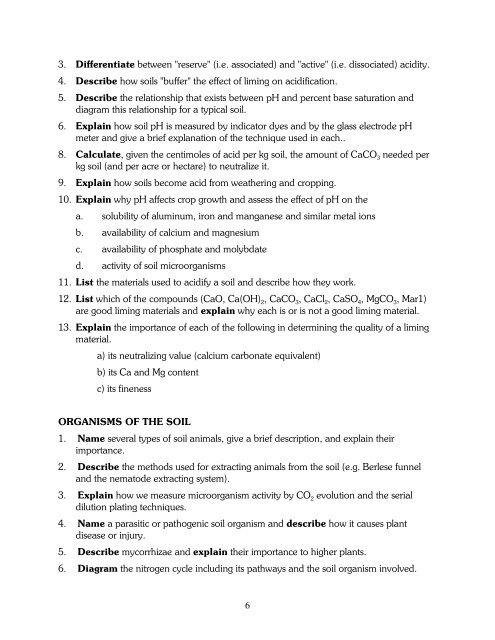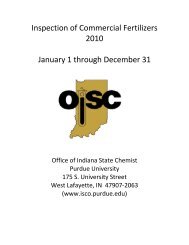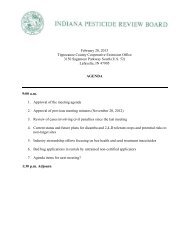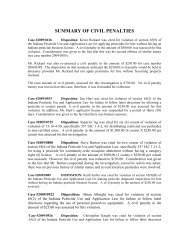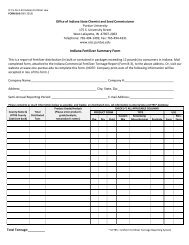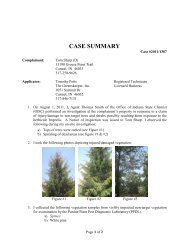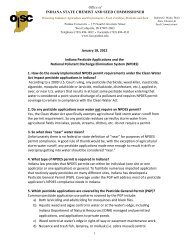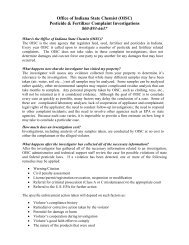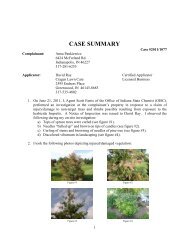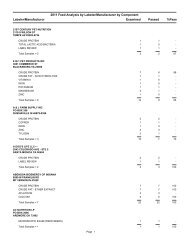Indiana Registry of Soil Scientists Performance Objectives for the ...
Indiana Registry of Soil Scientists Performance Objectives for the ...
Indiana Registry of Soil Scientists Performance Objectives for the ...
Create successful ePaper yourself
Turn your PDF publications into a flip-book with our unique Google optimized e-Paper software.
3. Differentiate between "reserve" (i.e. associated) and "active" (i.e. dissociated) acidity.<br />
4. Describe how soils "buffer" <strong>the</strong> effect <strong>of</strong> liming on acidification.<br />
5. Describe <strong>the</strong> relationship that exists between pH and percent base saturation and<br />
diagram this relationship <strong>for</strong> a typical soil.<br />
6. Explain how soil pH is measured by indicator dyes and by <strong>the</strong> glass electrode pH<br />
meter and give a brief explanation <strong>of</strong> <strong>the</strong> technique used in each..<br />
8. Calculate, given <strong>the</strong> centimoles <strong>of</strong> acid per kg soil, <strong>the</strong> amount <strong>of</strong> CaCO 3 needed per<br />
kg soil (and per acre or hectare) to neutralize it.<br />
9. Explain how soils become acid from wea<strong>the</strong>ring and cropping.<br />
10. Explain why pH affects crop growth and assess <strong>the</strong> effect <strong>of</strong> pH on <strong>the</strong><br />
a. solubility <strong>of</strong> aluminum, iron and manganese and similar metal ions<br />
b. availability <strong>of</strong> calcium and magnesium<br />
c. availability <strong>of</strong> phosphate and molybdate<br />
d. activity <strong>of</strong> soil microorganisms<br />
11. List <strong>the</strong> materials used to acidify a soil and describe how <strong>the</strong>y work.<br />
12. List which <strong>of</strong> <strong>the</strong> compounds (CaO, Ca(OH) 2 , CaCO 3 , CaCl 2 , CaSO 4 , MgCO 3 , Mar1)<br />
are good liming materials and explain why each is or is not a good liming material.<br />
13. Explain <strong>the</strong> importance <strong>of</strong> each <strong>of</strong> <strong>the</strong> following in determining <strong>the</strong> quality <strong>of</strong> a liming<br />
material.<br />
a) its neutralizing value (calcium carbonate equivalent)<br />
b) its Ca and Mg content<br />
c) its fineness<br />
ORGANISMS OF THE SOIL<br />
1. Name several types <strong>of</strong> soil animals, give a brief description, and explain <strong>the</strong>ir<br />
importance.<br />
2. Describe <strong>the</strong> methods used <strong>for</strong> extracting animals from <strong>the</strong> soil (e.g. Berlese funnel<br />
and <strong>the</strong> nematode extracting system).<br />
3. Explain how we measure microorganism activity by CO 2 evolution and <strong>the</strong> serial<br />
dilution plating techniques.<br />
4. Name a parasitic or pathogenic soil organism and describe how it causes plant<br />
disease or injury.<br />
5. Describe mycorrhizae and explain <strong>the</strong>ir importance to higher plants.<br />
6. Diagram <strong>the</strong> nitrogen cycle including its pathways and <strong>the</strong> soil organism involved.<br />
6


